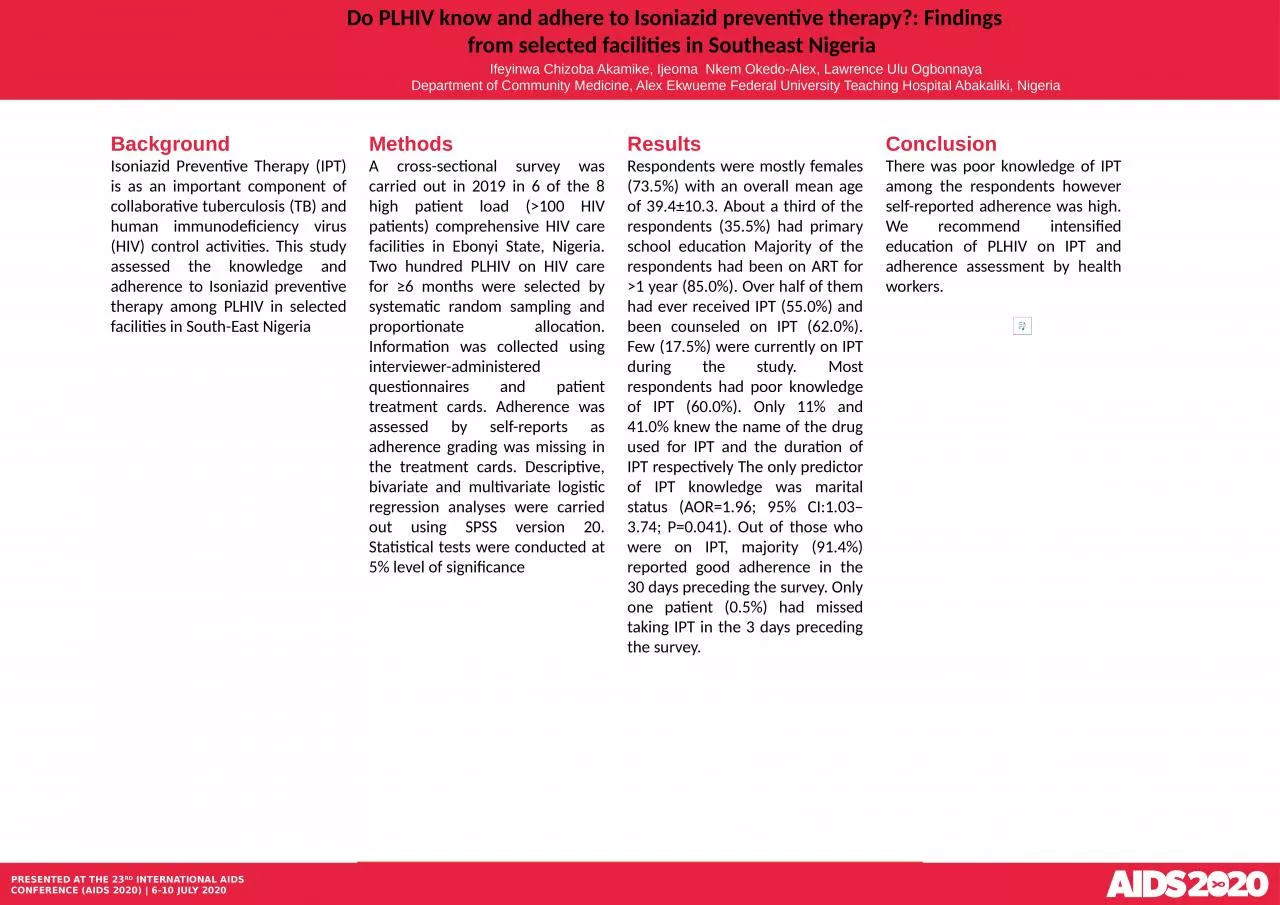

Methods A crosssectional survey was carried out in 2019 in 6 of the 8 high patient load gt100 HIV patients comprehensive HIV care facilities in Ebonyi State Nigeria Two hundred PLHIV on HIV care for ID: 934806
Download Presentation The PPT/PDF document "Background Isoniazid Preventive Therapy ..." is the property of its rightful owner. Permission is granted to download and print the materials on this web site for personal, non-commercial use only, and to display it on your personal computer provided you do not modify the materials and that you retain all copyright notices contained in the materials. By downloading content from our website, you accept the terms of this agreement.
Slide1
Background
Isoniazid Preventive Therapy (IPT) is as an important component of collaborative tuberculosis (TB) and human immunodeficiency virus (HIV) control activities. This study assessed the knowledge and adherence to Isoniazid preventive therapy among PLHIV in selected facilities in South-East Nigeria
MethodsA cross-sectional survey was carried out in 2019 in 6 of the 8 high patient load (>100 HIV patients) comprehensive HIV care facilities in Ebonyi State, Nigeria. Two hundred PLHIV on HIV care for ≥6 months were selected by systematic random sampling and proportionate allocation. Information was collected using interviewer-administered questionnaires and patient treatment cards. Adherence was assessed by self-reports as adherence grading was missing in the treatment cards. Descriptive, bivariate and multivariate logistic regression analyses were carried out using SPSS version 20. Statistical tests were conducted at 5% level of significance
Do PLHIV know and adhere to Isoniazid preventive therapy?: Findings from selected facilities in Southeast Nigeria
Ifeyinwa Chizoba Akamike, Ijeoma Nkem Okedo-Alex, Lawrence Ulu OgbonnayaDepartment of Community Medicine, Alex Ekwueme Federal University Teaching Hospital Abakaliki, Nigeria
PRESENTED AT THE 23
RD
INTERNATIONAL AIDS CONFERENCE (AIDS 2020) | 6-10 JULY 2020
Results
Respondents were mostly females (73.5%) with an overall mean age of 39.4±10.3. About a third of the respondents (35.5%) had primary school education Majority of the respondents had been on ART for >1 year (85.0%). Over half of them had ever received IPT (55.0%) and been counseled on IPT (62.0%). Few (17.5%) were currently on IPT during the study. Most respondents had poor knowledge of IPT (60.0%). Only 11% and 41.0% knew the name of the drug used for IPT and the duration of IPT respectively The only predictor of IPT knowledge was marital status (AOR=1.96; 95% CI:1.03–3.74; P=0.041). Out of those who were on IPT, majority (91.4%) reported good adherence in the 30 days preceding the survey. Only one patient (0.5%) had missed taking IPT in the 3 days preceding the survey.
ConclusionThere was poor knowledge of IPT among the respondents however self-reported adherence was high. We recommend intensified education of PLHIV on IPT and adherence assessment by health workers.